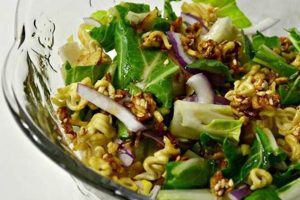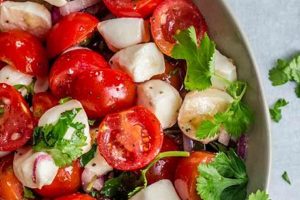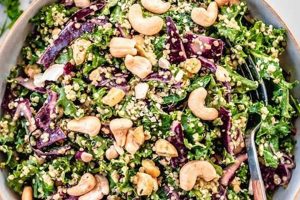A deconstructed Italian grinder transformed into a salad typically features the same ingredients as its sandwich counterpart. These include cured meats like salami, mortadella, capicola, and provolone cheese. Crisp vegetables such as shredded lettuce, sliced tomatoes, onions, and pepperoncini contribute texture and freshness. A vinaigrette, often oil and vinegar based, with oregano and other Italian herbs, provides the dressing, replicating the flavor profile of a traditional grinder.
This salad format offers a lighter alternative to a dense sandwich while retaining the beloved flavors. It provides dietary flexibility, accommodating gluten-free diets by omitting the bread. Furthermore, the salad presentation allows for easier portion control and customization of ingredient ratios. The concept likely emerged as a way to enjoy these classic Italian flavors in a fresher, more manageable way, adapting to evolving dietary preferences.
Discussions regarding this salad format often encompass variations in ingredients, dressings, and preparation methods. Exploring regional differences in grinder styles offers further insight into the salad’s diverse interpretations. Nutritional information and suggested pairings are also relevant considerations.
Tips for an Exceptional Italian Grinder Salad
Achieving optimal flavor and texture requires attention to detail throughout the preparation process. These tips offer guidance for creating a truly satisfying culinary experience.
Tip 1: High-Quality Ingredients are Key: Selecting premium cured meats and cheeses significantly impacts the overall flavor profile. Fresh, crisp vegetables are essential for textural contrast and vibrant presentation.
Tip 2: Dressing Matters: A balanced vinaigrette complements the robust flavors of the ingredients. Experimenting with different oils, vinegars, and herbs allows for personalized flavor combinations.
Tip 3: Proper Vegetable Preparation: Uniformly slicing vegetables ensures even distribution of flavor and texture. Thoroughly drying lettuce prevents a watery salad.
Tip 4: Cheese Selection: Provolone is traditional, but exploring other Italian cheeses like mozzarella or fontina can add depth and complexity.
Tip 5: Layering for Optimal Flavor: Strategically layering ingredients enhances the sensory experience. Consider placing more delicate items, like lettuce, on top to prevent them from being weighed down.
Tip 6: Freshly Made is Best: Preparing the salad just before serving maintains the integrity of the ingredients, preserving their flavors and textures.
Tip 7: Portion Control with Meat and Cheese: While tempting to overload, a balanced ratio of meat, cheese, and vegetables creates a more harmonious and enjoyable salad.
By following these guidelines, one can elevate a simple Italian grinder salad into a truly memorable dish, highlighting the vibrant flavors of Italian cuisine in a fresh and accessible format. These insights contribute to a more informed and enjoyable culinary endeavor.
By understanding these nuances, one can fully appreciate the potential of this versatile dish.
1. Fresh, Crusty Bread (Optional)
The inclusion of bread, while seemingly contradictory to the concept of a salad, offers a nuanced connection to the Italian grinder’s origins. A traditional grinder is defined by its substantial bread casing, filled with layers of cured meats, cheeses, and vegetables. The “grinder salad” deconstructs this classic sandwich, presenting the filling components as the star. Offering crusty bread alongside, often toasted or grilled, provides an optional callback to the sandwich’s structure, allowing for dipping or scooping, thereby echoing the grinder experience. This optional component bridges the gap between the salad’s lighter presentation and the satisfying heft of the original sandwich.
Consider a scenario where a diner craves the flavors of an Italian grinder but desires a lighter meal. The salad format fulfills this need. However, the textural satisfaction derived from biting into a crusty roll might be missed. Providing bread alongside addresses this potential gap, offering a more complete sensory experience. This choice allows for individual preference and customization, acknowledging the multifaceted nature of culinary enjoyment. Furthermore, the bread can serve as a vehicle for the vinaigrette, ensuring no flavor is lost. Dipping the bread into the dressing-coated salad enhances the overall enjoyment.
Understanding the optional bread’s role provides insight into the Italian grinder salad’s adaptability. It acknowledges the dish’s evolution from its sandwich predecessor while offering a means to maintain a connection to that origin. This nuanced approach elevates the dish beyond a simple deconstruction, transforming it into a versatile culinary expression that caters to a broader range of preferences and dietary needs. The bread’s presence, while optional, significantly contributes to a more comprehensive and customizable dining experience.
2. High-Quality Cured Meats
High-quality cured meats constitute a foundational element of an Italian grinder salad. Their presence significantly influences the overall flavor profile, texture, and aroma. The selection of these meats directly impacts the authenticity and enjoyment of the dish. Cured meats, by definition, undergo processes like salting, smoking, or drying, developing complex flavors absent in fresh meat. These processes also contribute to a distinct texture, ranging from the delicate folds of prosciutto to the firmer bite of soppressata. In the context of an Italian grinder salad, these meats provide a savory depth and a satisfying chew, complementing the other components.
For instance, consider the difference between generic salami and artisanal finocchiona. Generic salami often lacks the nuanced flavors derived from spices and careful curing. Finocchiona, with its distinctive fennel notes, introduces a layer of complexity that elevates the entire salad. Similarly, using thinly sliced prosciutto instead of pre-packaged, chopped ham significantly alters the textural and aromatic experience. The delicate, melt-in-your-mouth quality of prosciutto contrasts beautifully with the crisp vegetables and creamy cheese, contributing to a more refined and authentic Italian grinder salad. These distinctions demonstrate the importance of ingredient selection in achieving an optimal culinary outcome.
Selecting high-quality cured meats ensures an authentic and flavorful experience. The complexity derived from traditional curing methods enhances the overall sensory profile of the salad. While substitutions might offer cost savings, they often compromise the dish’s integrity. Understanding the crucial role of these meats allows for informed decisions that prioritize quality and flavor, ultimately leading to a more satisfying culinary experience. This attention to detail elevates the Italian grinder salad from a simple assembly of ingredients to a carefully considered composition of flavors and textures.
3. Sharp Provolone Cheese
Sharp provolone cheese plays a crucial role in defining the flavor profile of an Italian grinder salad. Its distinct characteristics contribute significantly to the overall balance and complexity of the dish, differentiating it from other salads. Understanding its specific contributions provides insight into the careful ingredient selection required for an authentic and satisfying culinary experience.
- Flavor Profile
Sharp provolone offers a robust, piquant taste that complements the richness of cured meats and the acidity of the vinaigrette. Its aged character provides a depth of flavor not found in milder cheeses. This sharpness cuts through the fattiness of the meats, creating a balanced and moreish flavor profile. For example, a sharp provolone aged for six months possesses a noticeably more assertive flavor than a younger, milder variety, significantly impacting the overall salad’s taste.
- Textural Contribution
Provolone’s semi-hard texture provides a pleasant chewiness that contrasts with the crisp vegetables and softer meats. This textural interplay enhances the sensory experience, making each bite more engaging. Consider the difference between thinly sliced provolone and shredded provolone in the salad. The sliced version offers distinct pockets of sharp flavor, while the shredded version distributes the flavor more evenly, influencing the overall mouthfeel.
- Melting Properties
While the Italian grinder salad typically features cold ingredients, the provolone’s melting properties become relevant if the optional bread is served toasted. The residual heat from the bread can gently soften the cheese, releasing its aromatic compounds and enhancing its flavor. This subtle melting action further integrates the cheese into the overall composition, creating a more cohesive culinary experience.
- Historical Context
Provolone’s inclusion in Italian-American cuisine reflects historical immigration patterns. Southern Italian immigrants introduced provolone to the United States, where it became a staple in sandwiches like the grinder. Its presence in the grinder salad represents a continuation of this culinary tradition, adding a layer of authenticity and historical significance to the dish.
The careful selection of sharp provolone cheese demonstrates a commitment to the authentic flavors of an Italian grinder salad. Its contribution extends beyond mere flavor, influencing the texture, aroma, and overall balance of the dish. Understanding these nuanced characteristics allows for a deeper appreciation of the culinary artistry involved in creating a truly satisfying and authentic Italian grinder salad experience. Substituting provolone with a milder cheese, or omitting it altogether, would significantly alter the intended flavor profile and diminish the connection to the classic Italian-American culinary tradition.
4. Crisp, Flavorful Vegetables
Crisp, flavorful vegetables constitute an essential element of an Italian grinder salad, providing textural contrast, vibrant color, and a refreshing counterpoint to the richness of the cured meats and cheese. Their inclusion extends beyond mere garnish, contributing significantly to the overall balance and enjoyment of the dish. A careful selection and proper preparation of these vegetables directly impacts the salad’s quality and authenticity.
Consider the interplay between thinly sliced red onion and the robust flavors of salami and provolone. The onion’s sharp bite cuts through the richness of the meat and cheese, preventing the flavors from becoming overwhelming. Simultaneously, crisp romaine lettuce offers a refreshing crunch, contrasting with the softer textures of the other components. The inclusion of other vegetables, such as sliced tomatoes, bell peppers, or pepperoncini, further enhances the complexity of flavors and textures. These elements combine to create a multi-sensory experience, ensuring each bite offers a balanced and satisfying combination of tastes and textures. Omitting these fresh elements would result in a denser, heavier dish, lacking the refreshing brightness that defines a well-composed Italian grinder salad.
The practical significance of incorporating crisp, flavorful vegetables lies in achieving a harmonious balance within the salad. These vegetables contribute not only to the nutritional value but also to the overall sensory appeal. The contrast in textures and flavors creates a more dynamic and engaging culinary experience. Furthermore, the visual appeal of vibrant vegetables enhances the presentation, making the salad more enticing. Challenges arise when vegetables lose their crispness due to improper storage or preparation. Limp lettuce or soggy tomatoes detract from the desired textural contrast. Therefore, proper handling, storage, and timely preparation are crucial for maximizing the positive impact of these essential components. The successful integration of crisp, flavorful vegetables elevates the Italian grinder salad from a simple combination of ingredients to a carefully constructed and balanced dish, demonstrating an understanding of flavor dynamics and textural interplay within the context of Italian-American culinary traditions.
5. Tangy Vinaigrette Dressing
Tangy vinaigrette dressing forms an integral component of an Italian grinder salad, serving to unify and enhance the diverse flavors of the individual ingredients. The dressing’s acidity, derived from vinegar or citrus juice, provides a crucial counterpoint to the richness of the cured meats and cheeses. This balance prevents the salad from becoming overly heavy, creating a more refreshing and palatable experience. Furthermore, the vinaigrette acts as a flavor bridge, connecting the disparate elementsmeats, cheeses, and vegetablesinto a cohesive whole. The specific characteristics of the vinaigrette, such as the type of oil, vinegar, and herbs used, significantly influence the overall flavor profile of the salad.
Consider a classic red wine vinaigrette. Its sharp acidity cuts through the fattiness of the salami and provolone, while the subtle fruity notes complement the sweetness of the tomatoes and onions. The inclusion of oregano and other Italian herbs further enhances the complexity, adding an aromatic dimension that complements the savory meats and cheeses. Alternatively, a lemon vinaigrette offers a brighter, more citrusy profile, particularly suitable for salads featuring lighter meats like prosciutto or chicken. This adaptability allows for variations within the Italian grinder salad framework, catering to individual preferences and specific ingredient combinations. Without a properly balanced vinaigrette, the individual flavors of the salad components might clash, resulting in a less harmonious and satisfying culinary experience. For example, a bland or overly oily dressing would fail to provide the necessary contrast, leading to a heavy, less palatable salad. Conversely, an excessively acidic dressing could overpower the delicate flavors of the other ingredients.
Understanding the crucial role of a tangy vinaigrette allows for informed decisions regarding ingredient selection and preparation. Choosing the appropriate type of vinegar, oil, and herbs ensures a balanced and flavorful salad. The proper emulsification of the dressing is equally crucial, preventing separation and ensuring even distribution of flavor throughout the salad. These considerations demonstrate the practical significance of recognizing the vinaigrette’s contribution to the overall composition. It highlights the interconnectedness of ingredients and the importance of balance in creating a successful and satisfying Italian grinder salad. Failure to appreciate this crucial element could compromise the integrity of the dish, diminishing its flavor complexity and overall appeal. The tangy vinaigrette, therefore, acts not merely as a condiment, but as a critical component that elevates the Italian grinder salad from a collection of individual ingredients to a harmoniously integrated culinary experience.
6. Proper Layering Technique
Proper layering technique significantly influences the overall enjoyment and structural integrity of an Italian grinder salad. Strategic layering prevents the more delicate components, such as lettuce, from becoming soggy by positioning them above the heavier, wetter ingredients like tomatoes and marinated items. This technique also ensures an even distribution of flavors and textures throughout the salad, maximizing the sensory experience of each bite. Consider the consequence of placing the lettuce at the bottom of the salad; it would inevitably wilt under the weight of the other ingredients, absorbing excess moisture and losing its desirable crispness. Conversely, placing heavier items, such as the cured meats and cheese, at the base provides a foundation and prevents them from crushing more delicate components. This thoughtful arrangement demonstrates an understanding of the interplay between ingredients and contributes to a more satisfying culinary experience.
Furthermore, proper layering contributes to the visual appeal of the salad. Arranging the ingredients in distinct layers showcases their individual colors and textures, enhancing the presentation and creating a more enticing dish. Imagine a salad where all the ingredients are haphazardly tossed together; the visual impact would be significantly diminished. The colors would blend, and the textural distinctions would be less apparent. Strategic layering, on the other hand, allows for a more aesthetically pleasing presentation, showcasing the vibrancy of the vegetables and the rich hues of the meats and cheese. This attention to detail elevates the salad beyond mere sustenance, transforming it into a visually appealing culinary creation.
In summary, proper layering in an Italian grinder salad is not merely an aesthetic consideration but a practical technique that impacts both the structural integrity and sensory experience of the dish. By strategically arranging the ingredients, one prevents sogginess, ensures even flavor distribution, and enhances the visual presentation. This understanding emphasizes the importance of considering the interplay between ingredients and underscores the difference between simply combining components and thoughtfully constructing a balanced and enjoyable salad. Overlooking this crucial element could compromise the overall quality and appeal of the dish, diminishing its textural and flavor complexity.
7. Attention to Ingredient Balance
Attention to ingredient balance constitutes a critical factor in a successful Italian grinder salad recipe. Balance refers to the harmonious interplay of flavors, textures, and proportions within the salad. This careful consideration prevents any single element from dominating the overall composition, ensuring a nuanced and enjoyable culinary experience. An imbalance, such as an overabundance of cured meats or an insufficient amount of acidic vinaigrette, can compromise the intended flavor profile and diminish the overall appeal of the salad. For instance, a salad dominated by sharp provolone might overwhelm the more delicate flavors of the vegetables, creating a disjointed and less satisfying taste experience. Conversely, a salad lacking sufficient acidity from the vinaigrette could become overly rich and heavy, failing to provide the necessary contrast to the meats and cheeses. The interplay of these elements underscores the importance of a considered approach to ingredient selection and proportion.
Ingredient balance extends beyond mere flavor considerations; it encompasses textural diversity as well. The crispness of the vegetables, the chewiness of the cured meats, and the creaminess of the provolone contribute to a multi-sensory experience. An excess of any one texture, such as an overabundance of crunchy elements or a lack of softer components, can disrupt this delicate balance. Imagine a salad composed primarily of shredded lettuce; while refreshing, it would lack the textural complexity that a balanced Italian grinder salad offers. The inclusion of heartier elements like cured meats and cheese provides a necessary textural counterpoint, creating a more engaging and satisfying culinary experience. Therefore, attention to textural balance contributes as significantly as flavor balance to the overall success of the dish. This interplay of textures adds depth and complexity, ensuring a more dynamic and enjoyable culinary experience.
In conclusion, achieving ingredient balance in an Italian grinder salad requires careful consideration of flavor profiles, textural nuances, and proportional relationships between components. This attention to detail distinguishes a thoughtfully composed salad from a haphazard collection of ingredients. Challenges arise when individual elements overpower the overall composition or when textural diversity is lacking. Successful execution hinges on a thorough understanding of the interplay between ingredients and a commitment to achieving a harmonious balance. This principle underscores the importance of viewing the Italian grinder salad not merely as a sum of its parts, but as an integrated whole where each component contributes to a unified and satisfying culinary experience. This nuanced approach elevates the dish from a simple combination of ingredients to a carefully crafted culinary composition.
Frequently Asked Questions
The following addresses common inquiries regarding the preparation and enjoyment of Italian grinder salads.
Question 1: Can other cheeses be substituted for provolone?
While provolone is traditional, mozzarella, fontina, or even a blend of Italian cheeses can offer interesting variations. However, consider how the cheese’s sharpness and texture contribute to the overall balance.
Question 2: What constitutes an authentic Italian vinaigrette?
Authenticity often relies on simplicity. High-quality olive oil, red wine vinegar, oregano, salt, and pepper are fundamental. Regional variations may incorporate garlic, Dijon mustard, or other herbs.
Question 3: How can sogginess be prevented?
Thoroughly drying lettuce after washing and strategically layering ingredients prevents excess moisture from accumulating at the bottom of the salad. Adding the dressing just before serving also helps.
Question 4: Is bread essential?
Bread is not a requirement for the salad itself. It serves as an optional accompaniment, referencing the grinder sandwich’s origins. Crusty Italian bread, toasted or grilled, enhances the experience.
Question 5: How can one adapt the salad for dietary restrictions?
Gluten-free diets easily accommodate the salad by omitting the bread. Adjustments to sodium content can be made by selecting lower-sodium cured meats and cheeses.
Question 6: What are suitable beverage pairings?
The robust flavors of the salad pair well with light-bodied red wines like Chianti or Pinot Noir. Crisp, dry white wines, such as Pinot Grigio, also complement the ingredients.
Understanding these frequently addressed points allows for greater flexibility and enjoyment of the Italian grinder salad. Adaptation and informed choices, while respecting traditional elements, enhance the culinary experience.
Further exploration of this culinary topic might delve into regional variations, specific ingredient recommendations, and nutritional analyses.
Conclusion
Exploration of the components of an Italian grinder salad reveals a dish grounded in tradition yet adaptable to modern preferences. Emphasis on high-quality ingredients, proper preparation techniques, and balanced flavor profiles underscores the potential for a truly satisfying culinary experience. From the careful selection of cured meats and cheeses to the nuanced interplay of textures and the essential role of the vinaigrette, each element contributes to the overall composition. Understanding these interconnected factors allows for informed choices regarding ingredient substitutions, adaptations for dietary restrictions, and creative variations while preserving the essence of the dish.
The Italian grinder salad stands as a testament to the evolution of culinary traditions. It offers a contemporary interpretation of classic Italian-American flavors, highlighting the adaptability of familiar ingredients. Further exploration and experimentation within this framework promise continued enjoyment and appreciation for this versatile and satisfying dish. Its enduring appeal lies in its ability to balance tradition with innovation, offering a culinary experience that is both familiar and refreshingly new.






